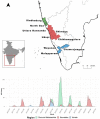Predicting Kyasanur forest disease in resource-limited settings using event-based surveillance and transfer learning
- PMID: 37422454
- PMCID: PMC10329696
- DOI: 10.1038/s41598-023-38074-0
Predicting Kyasanur forest disease in resource-limited settings using event-based surveillance and transfer learning
Abstract
In recent years, the reports of Kyasanur forest disease (KFD) breaking endemic barriers by spreading to new regions and crossing state boundaries is alarming. Effective disease surveillance and reporting systems are lacking for this emerging zoonosis, hence hindering control and prevention efforts. We compared time-series models using weather data with and without Event-Based Surveillance (EBS) information, i.e., news media reports and internet search trends, to predict monthly KFD cases in humans. We fitted Extreme Gradient Boosting (XGB) and Long Short Term Memory models at the national and regional levels. We utilized the rich epidemiological data from endemic regions by applying Transfer Learning (TL) techniques to predict KFD cases in new outbreak regions where disease surveillance information was scarce. Overall, the inclusion of EBS data, in addition to the weather data, substantially increased the prediction performance across all models. The XGB method produced the best predictions at the national and regional levels. The TL techniques outperformed baseline models in predicting KFD in new outbreak regions. Novel sources of data and advanced machine-learning approaches, e.g., EBS and TL, show great potential towards increasing disease prediction capabilities in data-scarce scenarios and/or resource-limited settings, for better-informed decisions in the face of emerging zoonotic threats.
© 2023. The Author(s).
Conflict of interest statement
The authors declare no competing interests.
Figures




Similar articles
-
Predicting disease risk areas through co-production of spatial models: The example of Kyasanur Forest Disease in India's forest landscapes.PLoS Negl Trop Dis. 2020 Apr 7;14(4):e0008179. doi: 10.1371/journal.pntd.0008179. eCollection 2020 Apr. PLoS Negl Trop Dis. 2020. PMID: 32255797 Free PMC article.
-
Kyasanur Forest Disease, is our surveillance system healthy to prevent a larger outbreak? A mixed-method study, Shivamogga, Karnataka, India: 2019.Int J Infect Dis. 2021 Oct;110 Suppl 1:S50-S61. doi: 10.1016/j.ijid.2021.07.076. Epub 2021 Aug 17. Int J Infect Dis. 2021. PMID: 34416404
-
A preliminary ecological profile of Kyasanur Forest disease virus hosts among the mammalian wildlife of the Western Ghats, India.Ticks Tick Borne Dis. 2020 Jul;11(4):101419. doi: 10.1016/j.ttbdis.2020.101419. Epub 2020 Mar 23. Ticks Tick Borne Dis. 2020. PMID: 32241712
-
Kyasanur forest disease: an epidemiological view in India.Rev Med Virol. 2006 May-Jun;16(3):151-65. doi: 10.1002/rmv.495. Rev Med Virol. 2006. PMID: 16710839 Review.
-
Clinical & epidemiological significance of Kyasanur forest disease.Indian J Med Res. 2018 Aug;148(2):145-150. doi: 10.4103/ijmr.IJMR_688_17. Indian J Med Res. 2018. PMID: 30381537 Free PMC article. Review.
Cited by
-
Sociodemographic factors associated with Kyasanur forest disease in India - a retrospective study.IJID Reg. 2024 Feb 15;10:219-227. doi: 10.1016/j.ijregi.2024.02.002. eCollection 2024 Mar. IJID Reg. 2024. PMID: 38440151 Free PMC article.
-
Meeting Global Health Needs via Infectious Disease Forecasting: Development of a Reliable Data-Driven Framework.JMIR Public Health Surveill. 2025 Mar 21;11:e59971. doi: 10.2196/59971. JMIR Public Health Surveill. 2025. PMID: 40116728 Free PMC article.
-
Exploration of effective pharmacological inhibitors for NS5 protein through computational approach: A strategy to combat the neglected Kyasanur forest disease virus.PLoS One. 2025 Jul 10;20(7):e0325613. doi: 10.1371/journal.pone.0325613. eCollection 2025. PLoS One. 2025. PMID: 40638564 Free PMC article.
-
Pylore Krishnaier Rajagopalan: Pioneer in Kyasanur Forest Disease Research and His Contributions to Zoonotic Disease Studies.Cureus. 2024 Sep 6;16(9):e68831. doi: 10.7759/cureus.68831. eCollection 2024 Sep. Cureus. 2024. PMID: 39376857 Free PMC article. Review.
-
Computational Exploration of Potential Pharmacological Inhibitors Targeting the Envelope Protein of the Kyasanur Forest Disease Virus.Pharmaceuticals (Basel). 2024 Jul 3;17(7):884. doi: 10.3390/ph17070884. Pharmaceuticals (Basel). 2024. PMID: 39065734 Free PMC article.
References
-
- Work TH, et al. Kyasanur Forest Disease III. A preliminary report on the nature of the infection and clinical manifestations in human beings. Indian J. Med. Sci. 1957;11:619–645. - PubMed
Publication types
MeSH terms
LinkOut - more resources
Full Text Sources

